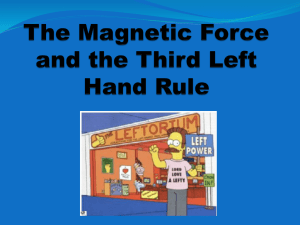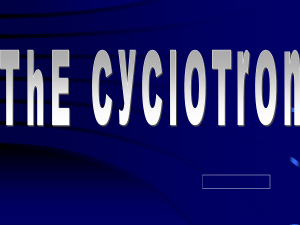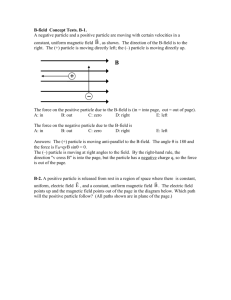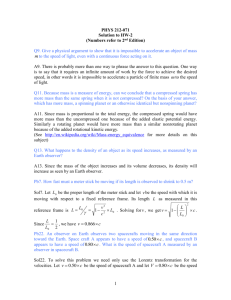Chapter 20 Concept Tests - University of Colorado Boulder
advertisement
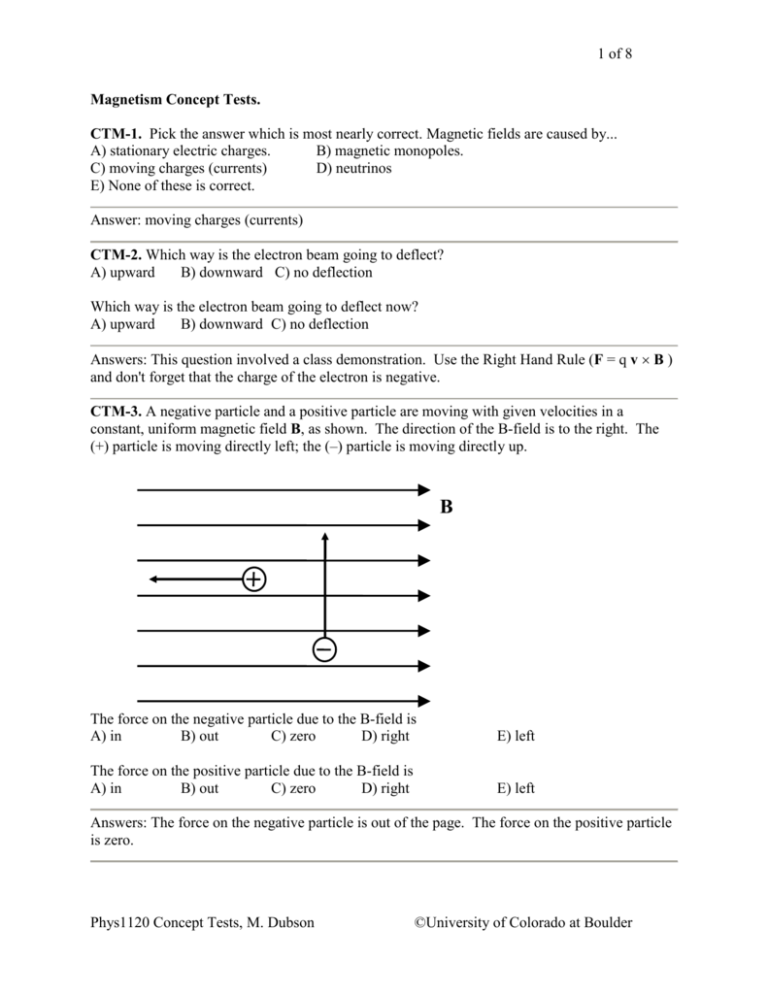
1 of 8 Magnetism Concept Tests. CTM-1. Pick the answer which is most nearly correct. Magnetic fields are caused by... A) stationary electric charges. B) magnetic monopoles. C) moving charges (currents) D) neutrinos E) None of these is correct. Answer: moving charges (currents) CTM-2. Which way is the electron beam going to deflect? A) upward B) downward C) no deflection Which way is the electron beam going to deflect now? A) upward B) downward C) no deflection Answers: This question involved a class demonstration. Use the Right Hand Rule (F = q v B ) and don't forget that the charge of the electron is negative. CTM-3. A negative particle and a positive particle are moving with given velocities in a constant, uniform magnetic field B, as shown. The direction of the B-field is to the right. The (+) particle is moving directly left; the (–) particle is moving directly up. B The force on the negative particle due to the B-field is A) in B) out C) zero D) right E) left The force on the positive particle due to the B-field is A) in B) out C) zero D) right E) left Answers: The force on the negative particle is out of the page. The force on the positive particle is zero. Phys1120 Concept Tests, M. Dubson ©University of Colorado at Boulder 2 of 8 CTM-4. A positive particle is released from rest in a region of space where there is constant, uniform, electric field E, and a constant, uniform magnetic field B. The electric field points up and the magnetic field points out of the page in the diagram below. Which path will the positive particle follow? A, B, and C in plane of diagram E A B C B(out) D) it will remain stationary E) it move out of the plane of the page The work done by the magnetic field on the particle is.. A) positive B) negative C) Zero. Answers: the particle will move upward and to the right (choice C). The magnetic field can do no work on the particle, since the force from the magnetic field is ALWAYS at right angles to the velocity and the displacement of the particle. Phys1120 Concept Tests, M. Dubson ©University of Colorado at Boulder 3 of 8 CTM-5. A proton (charge q = +e), moving to the right with an initial speed v, passes into a region where there is a vertical electric field pointing down and a horizontal magnetic field pointing into the page. Is it possible that the forces from the E- and B-fields cancel and the proton moves straight through undeflected. (Ignore gravity in this problem.) A) Yes, the forces can cancel and the particle moves straight through B) No, the forces cannot perfectly cancel; the particle path will be bent. +++++++++++++++++++++++ ??? + E B -------------------------------The E- and B-fields of the velocity selector are adjusted so that protons with a certain speed v pass through undeflected. Now electrons with the same speed are shot into the velocity selector (with same E- and B-fields as before). Do the electrons also pass through undeflected? A) Yes, the electrons go straight through B) No, the electrons are bent Answers: Yes, the forces can cancel so the particle can move straight through. Yes, the electrons also go straight through. Phys1120 Concept Tests, M. Dubson ©University of Colorado at Boulder 4 of 8 CTM-6.a. A particle with unknown charge (but non-zero) q and moving left with speed v enters a regions where there is a uniform electric field down and a uniform magnetic field out of the page. The particle is observed to go in a straight line. The charge of the particle must be ... A) positive B) negative C) impossible to determine. B v E b. Suppose the particle is a proton. If the speed of the proton is increased, it will A) still undergo no deflection B) deflect out of the plane of the page (toward you) C) deflect into the plane of the page (away from you) D) stay in the plane of the page and deflect upward E) stay in the plane of the page and deflect downward Answers: Impossible to tell the sign of the charge. It is possible that the charge could be either positive or negative. If the charge is positive the force from the E-field is down, the force from the B-field is up, and the forces cancel. But if charge is negative, both forces switch direction and the forces still cancel. In either case, the fact that the particles is moving with constant velocity implies that Fnet = 0. Since the net force is zero, the magnetic force (magnitude |q|vB) must cancel the electric force (magnitude |q|E). So we have vB = E (the |q|’s cancel), so only particles with speed v = E/B pass straight thru, regardless of the sign or magnitude of the charge. This device is called a velocity selector: only particle with this speed go straight thru; any other speed will result in a curving trajectory. If the speed of the proton is increased, the upward magnetic force will increase, while the force from the E-field is unchanged, and the particle will stay in the plane and deflect upward. Phys1120 Concept Tests, M. Dubson ©University of Colorado at Boulder 5 of 8 CTM-7. A particle is observed to be moving clockwise in a circle in a uniform B-field pointing into page, as shown. The charge of the particle is .. A) positive B) negative C) impossible to tell from the info given Answer: the charge must be negative, since the direction of the force must be toward the center of the loop. B(in) everywhere CTM-8. A positively-charged particle with an initial speed vo is moving in a plane perpendicular to a uniform magnetic field (B into the page). There is a tenuous gas throughout the region which causes viscous drag and slows the particle over time. The path of the particle is A) a spiral inward B) a spiral outward C) something else B b. If the time for the particle to complete the first revolution (once around) is 1 second, the time for the first 5 revolutions is A) > 5 s B) < 5 s C) 5 s Answers: It will spiral in. As the particle's speed v decreases, its orbital radius decreases according to R = (mv)/(qB). The period is 5s. The period T and the frequency f = 1/T are independent of the radius R or the speed v. The "cyclotron frequency" is f = (qB)/2m. As the speed v decreases, the radius R decreases in proportional. It moves more slowly, but around a smaller circle, so the time to go around once remains constant. Phys1120 Concept Tests, M. Dubson ©University of Colorado at Boulder 6 of 8 CTM-9. A current-carrying wire is in a B-field. The wire is parallel to the B-field as shown. What is the direction of the magnetic force on the wire? A) right B) left C) up D) down E) None of these. B I ` Answer: the force is zero CTM-10. A square loop of wire carrying current I is in a uniform magnetic field B. The loop is perpendicular to B (B out of the page). What is the direction of the net force on the wire? A) out of the page B (out) B) into the page C) D) E) None of these I The same loop is now in a non-uniform field. The field grows stronger near the top of the page. The direction of the net force is ... B stronger B A C D B weaker E) net force is zero Phys1120 Concept Tests, M. Dubson ©University of Colorado at Boulder 7 of 8 Answers: When the B-field is uniform, the net force is zero. The force on each side is F = I L B, where L is the edge length. The forces on each edge each point away from the square and so they cancel. In the non-uniform B-field, the net force is upward, since the upward force on the top wire is larger than the downward force on the bottom wire. CTM-11. A square loop of wire carrying current I is a uniform magnetic field and it can rotate about an axis, as shown. I B Seen from along the axis of rotation, the loop is tilted relative to the B-field as shown. B I(in) I(out) The magnetic forces on the loop from the B-field. A) will cause the loop to rotate counter-clockwise B) will cause the loop to rotate clockwise C) will not cause the loop to rotate. The direction of the torque on the loop is A) into the page B) out of the page C) to the right D) up E) None of these Answers: The magnetic forces will cause the loop to rotate clockwise. The direction of the torque is into the page (using either = r F or = B) Phys1120 Concept Tests, M. Dubson ©University of Colorado at Boulder 8 of 8 CTM-12. A square loop of wire carrying a current I, is in a constant uniform magnetic field B. The magnetic field is perpendicular to the plane of the loop. The loop can rotate freely about the axis. axis B Far edge I Near edge The loop tends to rotate so that the near edge moves.. A) to the right tend to move. B) to the left C) The net torque on the loop is zero, so it does not Answer: The net torque is zero; there is no tendency to rotate. Phys1120 Concept Tests, M. Dubson ©University of Colorado at Boulder
